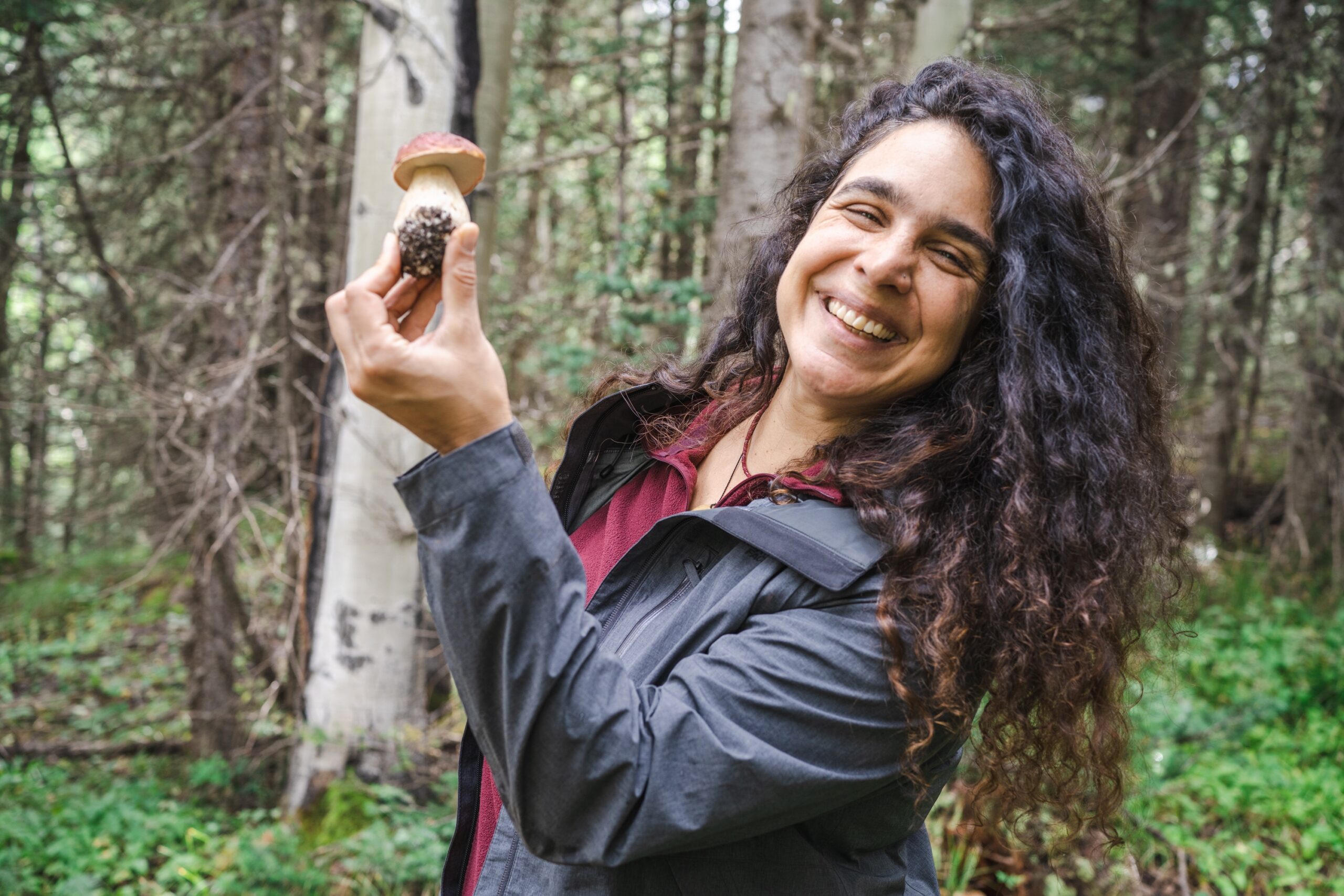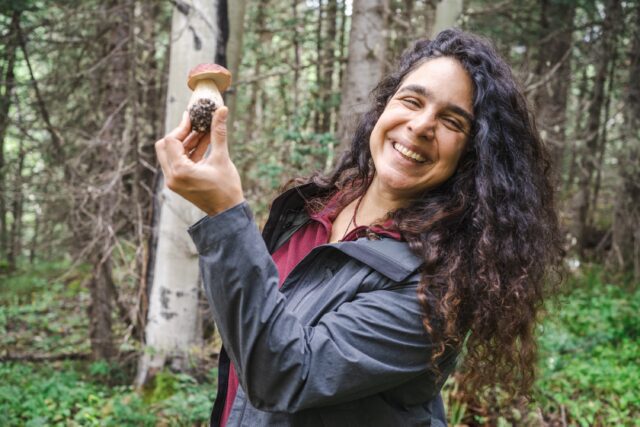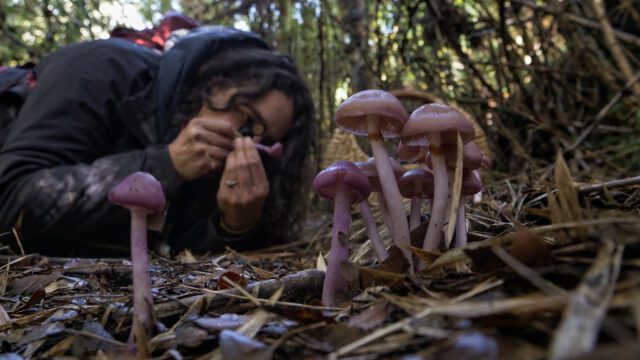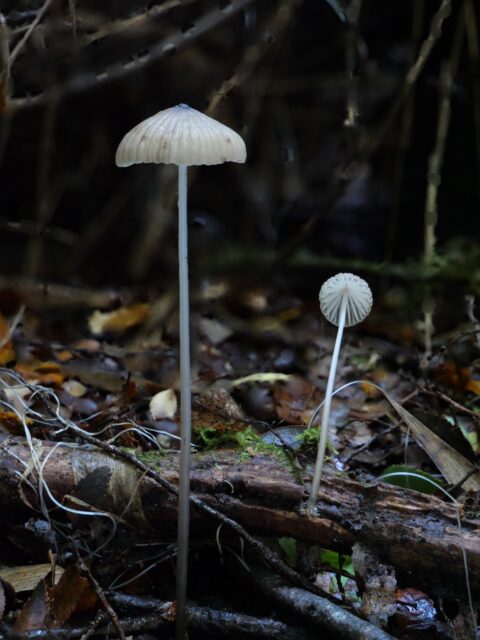
04 Aug Telluride Mushroom Festival: Guiliana Furci, Everywhere You Want to Be!
The Telluride Mushroom Festival (TMF) returns for the 44th year in a row. And when that happens – this year August 14 – August 18 –the Town of Telluride will be taken over by amanita hat-wearing, mold- and spore-worshipping mycelium fanatics.
Go here for more on the history of the Telluride Mushroom Festival. (Scroll back to 2009.)
And please scroll down to check out our interview with returning Festival favorite Guiliana Furci.

Mycophiles believe we humans owe our past, present and future to the existence of fungi on Earth. Many can heal; some can transform you forever; others can kill. And the list of their practical applications is endless: food, packaging, clothing, healing and more coming attractions.
“Through observing our teachers, the fungi, we can learn to be better people, to accept cycles, the end of cycles, the beginning of others, to let things rot…we have to let things rot,” said Guiliana Furci.
Giuliana is a mini-UN with maximal impact on the world of fungi – which means the world at large.
The Chilean-British-Italian field mycologist is a speaker, author, and founder of the world’s first non-profit organization dedicated to fungi, Fundación Fungi or Fungi Foundation. She is a Harvard University Associate, National Geographic Explorer, author of a series of mushroom field guides in Chile, co-chair of the IUCN Fungal Conservation Committee and co-author of titles such as the 1st State of the World’s Fungi and the paper delimiting the term ‘funga’ and the 3F Proposal – fauna, flora & funga.
Giuliana was also the first female mycologist of non-lichenized fungi in Chile. She was self-taught for 16 years because there was nowhere for her to study fungi in Chile.
Want to know more? Ask Guiliana, who is everywhere you want to be at the upcoming 44th annual Telluride Mushroom Festival.
Guiliana will be talking about the challenges in advocating for fungi and the journey to achieve a significant place for them in conservation efforts.
She appears in and will be answering questions about documentaries filmed during the same mycological expedition to Tierra del Fuego in Chile, Guiliana’s home country.
Giuliana is the moderator of panel charged with teasing out the meaning of identity from top mycologists and guests at this year’s TMF.
And she is one of the judges of the costumes that appear in the not-to- be missed Mushroom Parade.

Giuliana Furci, Credit, Mateo Barrenengoa.

Credit, Fungi Foundation,
For more, check out Guiliana’s answers to questions posed by Telluride Inside…and Out.
TIO: Guiliana. Take us back to your early history with mushrooms. How did the passion that has become your life’s work evolve.? What was the trigger?
GF: My passion for fungi in general, not just mushrooms, began in the year 1999 during a trip in the forest where I encountered a big orange mushroom and wanted to know who she was. But there were no books on Chilean fungi. It was then that this lightning bolt struck me: This is what I was born to do. That was the trigger. And then the passion just grew and grew and it still grows to date. Everyday I’m more passionate about fungi and love them more.
TIO: You were self-taught for 16 years. For those who are new to the mushroom game, how did you go about learning enough to lay the foundation for all that you do today in that world?
GF: Learning today is easier than it was when I started because of technology and the formats of the many available books are a lot more user-friendly than when I began studying them in 1999 and 2000. So what I would say to those who are new to the kingdom is read everything you can get your hands on. Try to meet mycologists who inspire you. Every time you see a fungus or a mushroom, collect it and try to learn the names and the nomenclature of the parts of a fungus. And always, always remember that there is a lot of space today to enjoy fungi and make discoveries. We don’t know everything about fungi, and we haven’t done everything for them either. Every single one of us has the potential to make significant changes in the lives of different fungi. It all depends on the commitment, the discipline, the hard work, and the will to learn.
TIO: Under your leadership your home country of Chile became the first country in the world to include Kingdom Fungi in its environmental legislation. Why is that designation important?
Thanks to our work, along with many other environmental organizations in Chile, in 2012 we became the first country in the world to include the fungi kingdom in environmental law. That means today Chile legally recognizes plants, animals, and fungi within the macroscopic diversity of the planet. It might sound obvious now, but we had to advocate for that to happen. In practical terms, the ruling mean that now, when evaluating the environmental impact of any proposed development project, funga must be considered in the equation at the same level as flora and fauna.
TIO: You founded the world’s first non-profit organization dedicated to fungi, Fundación Fungi or Fungi Foundation, which went international a few years ago. Please explain why and when you founded your nonprofit and what is its mission?
GF: After that first encounter in 1999, I spent several years working and going into the field to discover, photograph, and study. The recognition of the Kingdom Fungi by Chilean law was the final motivation to create Fundación Fungi (Fungi Foundation) in 2012, which was the first in the world to put fungi at the center of its mission.
Since then, we’ve continuously put all our efforts into the conservation of fungi, their habitats, and the people who depend on them. We educate about their ecological and cultural importance, work to document and protect their ancestral uses, and go on expeditions to explore and discover new species, in collaboration with people from all over the world in different disciplines.
TIO: Apparently your Fungi Foundation is now in the business of making documentaries. Please tease a bit about the two being shown at TMF this year.
GF: The Fungi Foundation has really evolved in storytelling. We have an incredible comms. team, and have had the opportunity to really think about fungi from a philosophical and ecological perspective with brilliant filmmakers like Mateo Barreningua, for example, with whom we made “Let Things Rot” and ‘Ten Days in the Forest.” Both of those are short, wonderfully moving pieces people really love. But we also have made films with partners like Merlin Sheldrake and Toby Kiers from SPUN, with whom we’ve been going to the forest for many years. We think and talk about ways to advance knowledge and protections for fungi and how we experience this work.
On the other hand, we’ve now gotten to the point where National Geographic has made a film about us, and that’s been really interesting. The National Geographic Society chose to document my work and that’s one of the movies we’re going to show this year in Telluride. It’s a short that showed at the Mountainfilm Festival in Telluride too, and it talks about my life’s effort to protect fungi.
That documentary was filmed in Tierra del Fuego in Patagonia, Chile, and after filming with National Geographic, Merlin, Toby and I went off with Mateo Barrenengoa and made another film titled “Seeing Fungi,” that hasn’t been shown yet.We are going to be showing that one too at TMF. The idea here is essentially to show how on the same expedition two very different films could be made on one very important subject: fungi.
TIO: Please preview the notion that man and fungi co-evolved.
GF: Different plants and animals have co-evolved with different species of fungi. You know, symbiosis, endosymbiosis. Plants couldn’t have emerged from an aquatic environment to conquer terrestrial land by themselves, not without co-evolving with fungi. Same for different animals. But there’s also a cultural co-evolution. Humanity has culturally co-evolved with different species of fungi, like yeasts, for example, yeast to ferment plants, yeast to make bread, to make beers and fermented liquids. We have co-evolved culturally with molds, for example, that help us preserve meat. We have culturally co-evolved with conks, wood ears that help us start fires, and so on.
TIO: How many years have you attended the TMF? How has the weekend impacted your life and work. How would you sum up the magic of TMF?
GF: I have attended the Telluride Mushroom Festival for nine years now, with only two years missing. I couldn’t make it last year because my son was ill. Then there was the year of the pandemic when the event was virtual.
TMF has been one of the most important spaces of my career. I not only found a family. I also found my tribe. I have made long-lasting professional and personal bonds with people from the mycology space, also outside the mycology space.
The Fungi Foundation has found its most sustaining funders through the Telluride Mushroom Festival.
Summing up what the Telluride Mushroom Festival means to me is hard because it’s hard to hold magic in your hands. But one thing is for sure is that the Telluride Mushroom Festival is magic.


Sorry, the comment form is closed at this time.